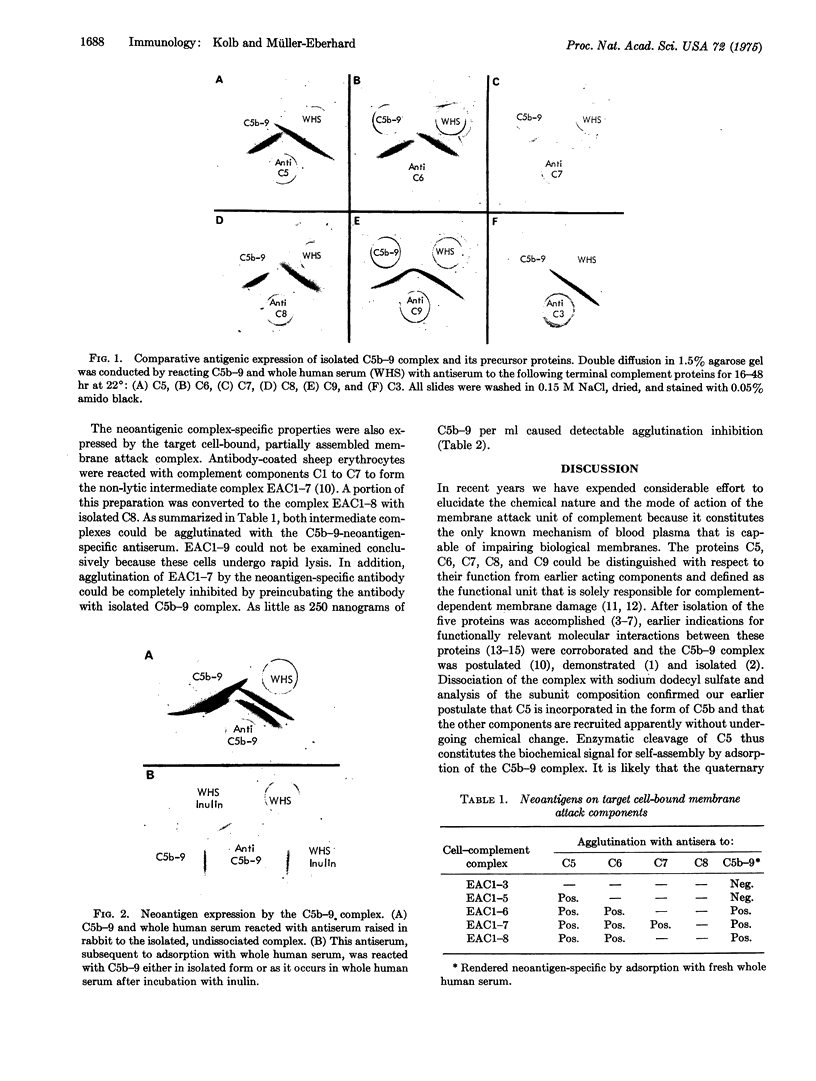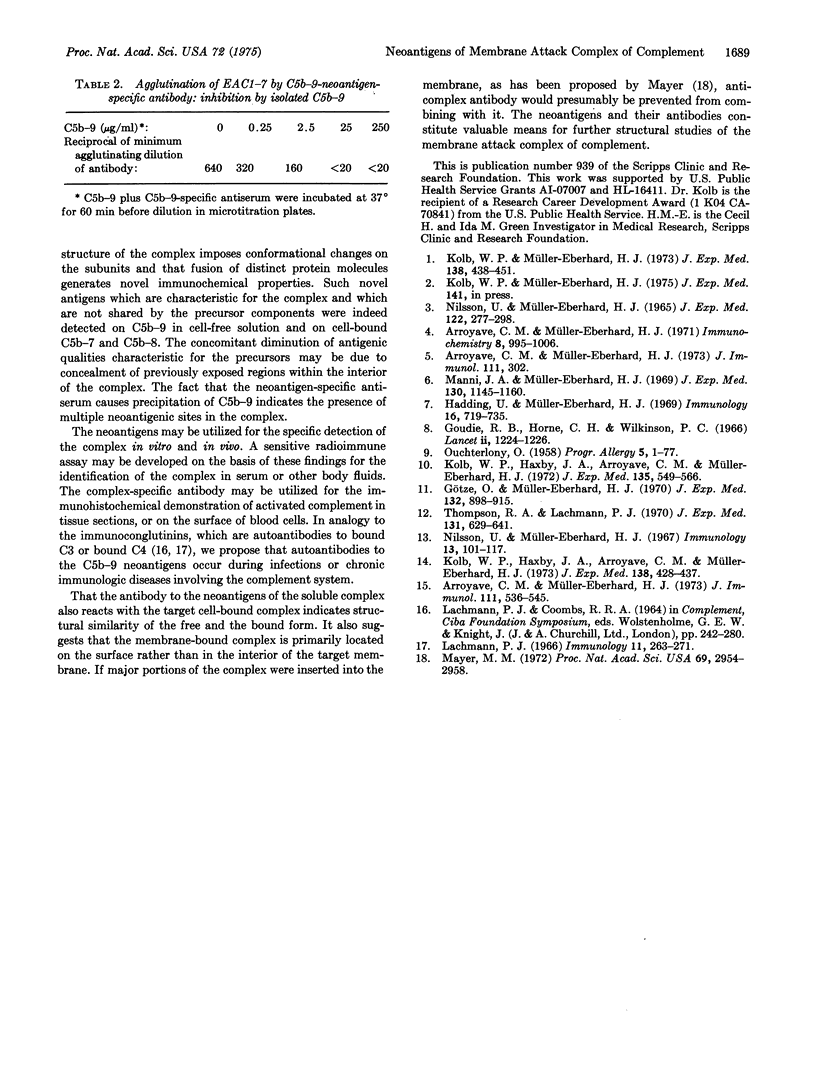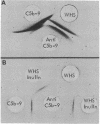Abstract
The membrane attack complex of complement is a fusion product of five complement proteins: C5b, C6, C7, C8, and C9. The complex causes complement-dependent cell membrane damage. It is assembled following complement activation both on the target cell surface and in the fluid phase. The isolated soluble complex, which has a molecular weight of one million, exhibited reduced expression of the antigenic determinants of the native precursor proteins. Antisera produced to the intact complex contained antibodies to neoantigens which were not detectable on the five precursor proteins. Antisera were rendered neoantigen-specific by adsorption with fresh human serum. Since the adsorbed antisera precipitated the complex, the complex must contain multiple neoantigenic sites. The complex-specific antibodies not only reacted with the soluble complex, but also with the target cell-bound membrane attack complex.
Full text
PDF


Images in this article
Selected References
These references are in PubMed. This may not be the complete list of references from this article.
- Arroyave C. M., Müller-Eberhard H. J. Interactions between human C5, C6, and C7 and their functional significance in complement-dependent cytolysis. J Immunol. 1973 Aug;111(2):536–545. [PubMed] [Google Scholar]
- Arroyave C. M., Müller-Eberhard H. J. Isolation of the sixth component of complement from human serum. Immunochemistry. 1971 Nov;8(11):995–1006. doi: 10.1016/0019-2791(71)90487-3. [DOI] [PubMed] [Google Scholar]
- Goudie R. B., Horne C. H., Wilkinson P. C. A simple method for producing antibody specific to a single selected diffusible antigen. Lancet. 1966 Dec 3;2(7475):1224–1226. doi: 10.1016/s0140-6736(66)92305-1. [DOI] [PubMed] [Google Scholar]
- Götze O., Müller-Eberhard H. J. Lysis of erythrocytes by complement in the absence of antibody. J Exp Med. 1970 Nov;132(5):898–915. doi: 10.1084/jem.132.5.898. [DOI] [PMC free article] [PubMed] [Google Scholar]
- Hadding U., Müller-Eberhard H. J. The ninth component of human complement: isolation, description and mode of action. Immunology. 1969 Jun;16(6):719–735. [PMC free article] [PubMed] [Google Scholar]
- Kolb W. P., Haxby J. A., Arroyave C. M., Müller-Eberhard H. J. Molecular analysis of the membrane attack mechanism of complement. J Exp Med. 1972 Mar 1;135(3):549–566. doi: 10.1084/jem.135.3.549. [DOI] [PMC free article] [PubMed] [Google Scholar]
- Kolb W. P., Haxby J. A., Arroyave C. M., Müller-Eberhard H. J. The membrane attack mechanism of complement. Reversible interactions among the five native components in free solution. J Exp Med. 1973 Aug 1;138(2):428–437. doi: 10.1084/jem.138.2.428. [DOI] [PMC free article] [PubMed] [Google Scholar]
- Kolb W. P., Müller-Eberhard H. J. The membrane attack mechanism of complement. Verification of a stable C5-9 complex in free solution. J Exp Med. 1973 Aug 1;138(2):438–451. doi: 10.1084/jem.138.2.438. [DOI] [PMC free article] [PubMed] [Google Scholar]
- Lachmann P. J. A sedimentation pattern technique for measuring conglutination: its application to demonstrating immunoconglutinins to C'4. Immunology. 1966 Sep;11(3):263–271. [PMC free article] [PubMed] [Google Scholar]
- Manni J. A., Müller-Eberhard H. J. The eighth component of human complement (C8): isolation, characterization, and hemolytic efficiency. J Exp Med. 1969 Nov 1;130(5):1145–1160. doi: 10.1084/jem.130.5.1145. [DOI] [PMC free article] [PubMed] [Google Scholar]
- Mayer M. M. Mechanism of cytolysis by complement. Proc Natl Acad Sci U S A. 1972 Oct;69(10):2954–2958. doi: 10.1073/pnas.69.10.2954. [DOI] [PMC free article] [PubMed] [Google Scholar]
- NILSSON U. R., MUELLER-EBERHARD H. J. ISOLATION OF BETA IF-GLOBULIN FROM HUMAN SERUM AND ITS CHARACTERIZATION AS THE FIFTH COMPONENT OF COMPLEMENT. J Exp Med. 1965 Aug 1;122:277–298. doi: 10.1084/jem.122.2.277. [DOI] [PMC free article] [PubMed] [Google Scholar]
- Nilsson U. R., Müller-Eberhard H. J. Studies on the mode of action of the fifth, sixth and seventh component of human complement in immune haemolysis. Immunology. 1967 Jul;13(1):101–117. [PMC free article] [PubMed] [Google Scholar]
- OUCHTERLONY O. Diffusion-in-gel methods for immunological analysis. Prog Allergy. 1958;5:1–78. [PubMed] [Google Scholar]
- Thompson R. A., Lachmann P. J. Reactive lysis: the complement-mediated lysis of unsensitized cells. I. The characterization of the indicator factor and its identification as C7. J Exp Med. 1970 Apr 1;131(4):629–641. doi: 10.1084/jem.131.4.629. [DOI] [PMC free article] [PubMed] [Google Scholar]




